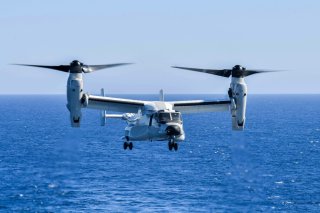The Marines’ V-22 Osprey Is Ready to Conquer the Indo-Pacific
The continued presence of Marine aviation and strengthened relationships with U.S. allies and partners are critical to maintaining a free and open Indo-Pacific.
The U.S. Marine Corps is gearing up for a serious fight in the Indo-Pacific. Cognizant of China’s expansionist intentions and alarmed by Beijing’s rhetoric toward Taiwan, the Marine Corps is undergoing some of the most significant changes in its history.
It is all part of the Commandant of the Marine Corps’ Force Design 2030 plan, which aims to optimize the Corps for the Indo-Pacific’s maritime environment. Rather than acting as a second land army equipped to fight long, grinding campaigns in the Middle East, the Marine Corps is becoming reacquainted with its maritime heritage.
The Indo-Pacific is, however, the world’s largest maritime theater, and moving Marines and supplies from Hawaii to Guam and elsewhere in the region is not easy. But the Marine Corps believes the MV-22 Osprey has the range to conquer the region’s distances.
A statement from the Marine Corps explained that the Marine Medium Tiltrotor Squadron 268 flew 6,100 miles from Australia to Hawaii following the end of an operational deployment.
“The MV-22s are capable and versatile aircraft for operations in the Pacific,” said Capt. John Wilkinson, a pilot assigned to VMM-268.
The transpacific flight demonstrates MAG-24’s ability to provide movement and maneuver capabilities for ground forces throughout the vastness of the Indo-Pacific area of responsibility. “MV-22s, coupled with KC-130s, provide unparalleled mobility at the tactical level,” said Colonel Herrington in the Marine Corps statement.
“With these aircraft, MAG-24 can put Marines and equipment anywhere in the Pacific.” “These capabilities,” Col. Manlee Herrington explained, “enable us to experiment and implement operational concepts critical to developing the Fleet Marine Force of the future.”
The flight had special significance for the Marine Corps. “Each stop on the transpacific flight – Australia, Fiji, American Samoa, and the Republic of Kiribati – are historically significant in the South Pacific and steeped in Marine Corps lore,” the statement explained. “The islands served as expeditionary staging bases for the U.S. and its allies in World War II, places that led ultimately, to the lasting peace, prosperity, and security present in the region for nearly 80 years.”
“Continued presence of Marine aviation and strengthened relationships with our allies and partners in the region is critical to maintaining a free and open Indo-Pacific. 1st Marine Aircraft Wing and MAG-24 support a wide array of operations throughout the Indo-Pacific alongside our allies and partners, continuing to be a strength to national and regional security.”
Caleb Larson is a multimedia journalist and defense writer with the National Interest. A graduate of UCLA, he also holds a Master of Public Policy and lives in Berlin. He covers the intersection of conflict, security, and technology, focusing on American foreign policy, European security, and German society for both print and radio. Follow him on Twitter @calebmlarson
Image: DVIDS.

